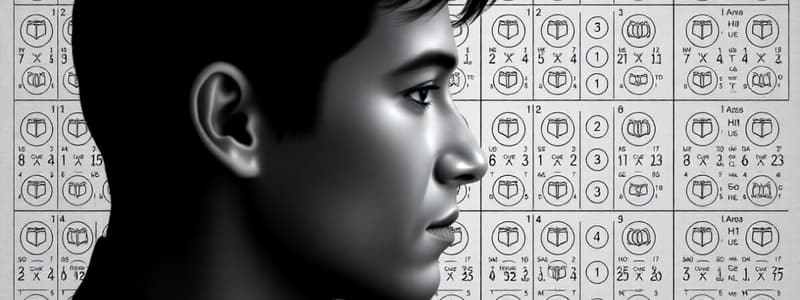Podcast
Questions and Answers
What does the Minnesota Multiphasic Personality Inventory (MMPI) primarily assess?
What does the Minnesota Multiphasic Personality Inventory (MMPI) primarily assess?
- Projective thoughts via storytelling
- Personality traits through self-report (correct)
- Psychological preferences based on environment
- Drawing skills and visual-motor coordination
Which personality assessment is based on Carl Jung's theories?
Which personality assessment is based on Carl Jung's theories?
- Eysenck Personality Inventory (EPI)
- Thematic Apperception Test (TAT)
- Cattrell's 16 PFQ
- Myers-Briggs Type Indicator (MBTI) (correct)
What is the primary measurement focus of the Eysenck Personality Inventory (EPI)?
What is the primary measurement focus of the Eysenck Personality Inventory (EPI)?
- Cognitive dissonance in personality
- Two independent dimensions of personality (correct)
- Attachment styles in relationships
- Power dynamics in social interactions
What is the goal of the Thematic Apperception Test (TAT)?
What is the goal of the Thematic Apperception Test (TAT)?
Which assessment uses a projective technique involving sentence completion?
Which assessment uses a projective technique involving sentence completion?
What does the Draw a Man Test evaluate?
What does the Draw a Man Test evaluate?
Which of the following traits is NOT part of the Big Five personality model?
Which of the following traits is NOT part of the Big Five personality model?
How many primary traits does Cattrell's 16 PFQ measure?
How many primary traits does Cattrell's 16 PFQ measure?
What is the main purpose of the International Personality Disorder Examination (IPDE)?
What is the main purpose of the International Personality Disorder Examination (IPDE)?
Which of the following assessments focuses on independent personality dimensions?
Which of the following assessments focuses on independent personality dimensions?
Flashcards
MMPI (Minnesota Multiphasic Personality Inventory)
MMPI (Minnesota Multiphasic Personality Inventory)
A personality inventory widely used, it assesses various aspects of an individual's personality, including emotional stability, social introversion/extroversion, and psychopathology.
MBTI (Myers-Briggs Type Indicator)
MBTI (Myers-Briggs Type Indicator)
A widely recognized personality assessment tool that classifies individuals based on four psychological preferences: Extraversion/Introversion, Sensing/Intuition, Thinking/Feeling, and Judging/Perceiving.
TAT (Thematic Apperception Test)
TAT (Thematic Apperception Test)
A projective test designed to uncover unconscious thoughts and motivations. Individuals are presented with ambiguous images and asked to create stories about them, revealing underlying themes.
Sentence Completion Test
Sentence Completion Test
Signup and view all the flashcards
Cattrell's 16 PFQ (Personality Factor Questionnaire)
Cattrell's 16 PFQ (Personality Factor Questionnaire)
Signup and view all the flashcards
EPI (Eysenck Personality Inventory)
EPI (Eysenck Personality Inventory)
Signup and view all the flashcards
Draw a Man Test
Draw a Man Test
Signup and view all the flashcards
IPDE (International Personality Disorder Examination)
IPDE (International Personality Disorder Examination)
Signup and view all the flashcards
The Big Five (Personality Traits)
The Big Five (Personality Traits)
Signup and view all the flashcards
Personality Inventory
Personality Inventory
Signup and view all the flashcards
Study Notes
Personality Assessments
- Minnesota Multiphasic Personality Inventory (MMPI): Completed by the individual, not the physician. It's a commonly used personality inventory.
Myers-Briggs Type Indicator (MBTI)
- A psychometric tool measuring psychological preferences in how individuals perceive the world and make decisions.
- Based on Carl Jung's work.
Thematic Apperception Test (TAT)
- A projective test.
- Individuals are shown pictures and asked to create stories associated with them.
- Questions on thoughts and feelings are asked.
- Unconscious themes are explored through the stories.
Sentence Completion Test
- A projective test.
- Individuals are given incomplete sentences and asked to complete them.
- Their responses reveal unconscious themes.
Cattrell's 16 PFQ
- A multiple-choice personality questionnaire.
- Uses factor analysis and correlation to measure 16 primary traits.
- Also measures the "Big Five" secondary traits.
- Developed by Raymond Cattrell.
Eysenck Personality Inventory (EPI)
- Measures two key personality dimensions:
- Extraversion-Introversion
- Neuroticism-Stability.
- These dimensions account for most personality variance.
- Eysenck developed a three-factor model: conscientiousness, extraversion, and neuroticism.
Draw-A-Man Test
- Involves drawing a man, a woman, and the individual themselves.
- Also has instructions to draw a whole person without specifications.
- Used to assess personality, intelligence, sensory defects, developmental progress, and visual-motor coordination.
International Personality Disorder Examination (IPDE)
- A consistent method to assess personality disorders.
- Uses both a self-administered questionnaire and a semi-structured interview.
- Addresses DSM-5 and ICD-10 standards.
The Big Five
- Conscientiousness
- Extraversion
- Neuroticism
- Openness (to experience)
- Agreeableness
Studying That Suits You
Use AI to generate personalized quizzes and flashcards to suit your learning preferences.




